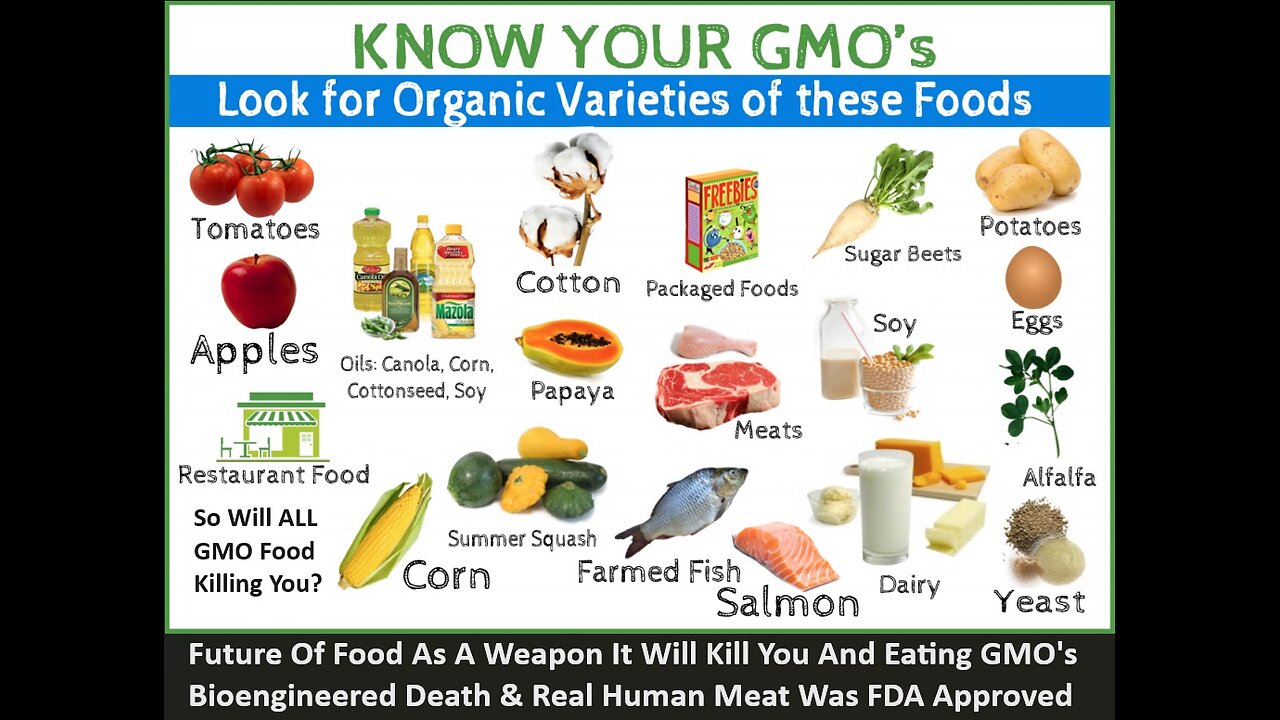Premium Only Content

Future Of Food As A Weapon It Will Kill You And Eating GMO's Bioengineered Death
Future Of Food As A Weapon It Will Kill You And Eating GMO's Bioengineered Death And Creation Of A Factory Farming System. The notion that genetically modified organisms (GMOs) and bioengineering will lead to a catastrophic future of food as a weapon, resulting in widespread death, is an exaggerated and unfounded claim. Here’s a balanced view:
GMOs in food: Many GMO crops are used to produce ingredients in common American foods, such as cornstarch, corn syrup, soybean oil, and canola oil. While some concerns exist, there is no conclusive evidence linking GMO consumption to increased cancer risk or DNA changes. The American Cancer Society states that current research does not support a link between GMOs and cancer.
Bioengineering and biowarfare: While genetic engineering has been explored for military applications, including biowarfare, this is a highly regulated and restricted area. The development of genetically engineered pathogens for military use is illegal under international treaties, and the scientific community has condemned such research.
Labeling and transparency: As of 2022, the USDA requires food manufacturers to label bioengineered foods with the term “bioengineered” or display a scannable code providing information on GMO ingredients. This increased transparency aims to empower consumers to make informed choices.
Future prospects: Genetic engineering and biotechnology will continue to evolve, potentially leading to innovations in food production, disease resistance, and sustainable agriculture. However, it is crucial to prioritize responsible research, strict regulations, and public awareness to ensure these advancements benefit humanity, not harm it.
In conclusion, while GMOs and bioengineering pose some risks and uncertainties, the notion of a catastrophic, deadly future is unfounded. By promoting responsible research, transparency, and public education, we can harness the potential benefits of these technologies while minimizing potential harms.
GMO is out, 'bioengineered' is in, as new U.S. food labeling rules take effect. Say goodbye to GMOs. The new term for foods created with a boost from science is "bioengineered."
As of Jan. 1, food manufacturers, importers and retailers in the U.S. must comply with a new national labeling standard for food that's been genetically modified in a way that isn't possible through natural growth.
Consumers will begin to see labels on some foods that say "bioengineered" or "derived from bioengineering," as the new federal standard takes hold and replaces the former patchwork of state-level requirements.
The change has been several years in the making. In 2016, Congress passed a law to establish a national benchmark for the labeling of genetically modified food in an attempt to give people more information about what they eat and standardize labels across the country. Sonny Perdue, who served as agriculture secretary during the Trump administration, announced the regulations in 2018.
"The National Bioengineered Food Disclosure Standard increases the transparency of our nation's food system, establishing guidelines for regulated entities on when and how to disclose bioengineered ingredients," Perdue said at the time. "This ensures clear information and labeling consistency for consumers about the ingredients in their food."
But critics say the rules devised by the U.S. Department of Agriculture will actually confuse consumers further and make it harder to know what's in any given product. One advocacy group has even sued the USDA to try to block the new regulations from taking effect.
The new rules give food producers a few options
Some commonly bioengineered foods include corn, canola, soybeans and sugar beets. Most GMO crops are used for animal feed, according to the Food and Drug Administration. But they are also used to make ingredients that routinely find their way into human diets, such as cornstarch, corn syrup, canola oil and granulated sugar.
The USDA says that the list of items on its website isn't exhaustive and that other foods with genetic modifications will be subject to the labeling rules.
Companies with products that qualify as bioengineered can comply with the new standard in several ways.
They can include text on food packages that says "bioengineered food" or "contains a bioengineered food ingredient." They can also use two logos approved by the USDA.
Finally, they can include a QR code for consumers to scan or a phone number for them to text that will provide more information about that food item.
The new standard applies to genetically modified foods as well as foods with genetically modified ingredients that are "detectable" by certain standards.
Shoppers who suspect an unlabeled item is actually a bioengineered food can file a complaint with the USDA's Agricultural Marketing Service.
Establishments like restaurants don't have to comply with the new rule, but they can do so voluntarily.
The logos are confusing and the rules don't go far enough, critics say
The Center for Food Safety, one advocacy group opposed to the new standard, says it makes it easier for companies to conceal what's in their products and leaves consumers in the dark.
Although there's no evidence that genetically modified crops are harmful to human health, according to the National Academy of Sciences and the World Health Organization, advocates say people still deserve to know what they're eating.
"These regulations are not about informing the public but rather designed to allow corporations to hide their use of genetically engineered ingredients from their customers," Andrew Kimbrell, executive director of the Center for Food Safety, said in a statement.
The group has sued the USDA in federal court in an attempt to block the new rules. The case remains ongoing.
The new standard doesn't allow producers to use more common labeling terms like "GMO," the lawsuit argues, and it will leave out many foods that are "highly refined" or contain levels of bioengineered ingredients that aren't detectable, such as soda and cooking oil. The group estimates that the majority of genetically modified food are processed items with genetically modified ingredients.
Additionally, the new standard discriminates against the poor, the elderly, people who live in rural areas and minorities who may lack a smartphone or access to the internet, the group said. It also puts an "undue burden" on shoppers to scan food items in stores during a deadly pandemic, advocates have argued.
Producers have also argued that the rule changes come at a bad time, with the ongoing pandemic and supply-chain woes that's making it a challenge to meet consumer demand, The Washington Post reported.
The USDA declined to comment for this story, citing the pending lawsuit. But a spokesperson for the agency told the Post that the new rules are meant to balance the desire to keep consumers better informed with the interest of minimizing costs for producers.
Despite other criticism, groups such as the American Soybean Association and the National Corn Growers Association praised the new standard when it was announced in 2018, saying it would create more transparency in the food industry.
We all know the problems of the modern factory farming system. But, as bad as things are, they’re about to get even worse. New technologies are coming online that threaten to upend our understanding of food altogether. Technologies that could, ultimately, begin altering the human species itself. This is The Future of Food on The Corbett Report.
https://corbettreport.com/future-of-food/
Nothing to See Here “Accidental Destruction” Food Processing Plant Fire Suspicious - https://rumble.com/v2axqu6-nothing-to-see-here-accidental-destruction-food-processing-plant-fire-suspi.html
Why are so many food processing plants and warehouses catching fire all of a sudden? Recent fires at food processing facilities have some claiming there’s more going on than meets the eye. Experts aren’t convinced. Experts say there’s no credence to recent internet rumors that a number of fires at food processing plants across the country are suspicious or in some way linked.
Everything You Need To Know About Eating Live Insects Wild Edibles Of The World - https://rumble.com/v341blk-everything-you-need-to-know-about-eating-live-insects-wild-edibles-of-the-w.html
Everything You Need To Know About Eating Live Insects With a growing world population and diminishing resources, we explore the sustainable option of edible insects. Eating insects can be a part of the solution to our planet’s growing food and climate crises. Throughout our history, humans around the world have consumed these protein and nutrient-rich creatures. This hasn't been widely adopted as part of modern Western diets, however things may be changing. A growing number of consumers in the West are now embracing entomophagy, or insect-eating.
chrome-extension://efaidnbmnnnibpcajpcglclefindmkaj/https://www.usaid.gov/sites/default/files/2022-12/Systemic-Solutions-for-Climate-Change-Adaptation-and-Mitigation-WORKING-PAPER-Oct-2022.pdf
What Is Lab Grown Meat ? How Is It Made From Beef To Human Meat Cell Guide Etc.. - https://rumble.com/v31vj1c-what-is-lab-grown-meat-how-is-it-made-from-beef-to-human-meat-cell-guide-et.html
How Lab-Grown Meat Is Made From Beef, Chickens, Cats, Dogs, Fish To Human Body Meat And Has FDA's Approval For The First Time Although access to it has been limited throughout the years, lab-cultivated meat is not a new concept. In fact, it first appeared in 2013 when scientist Mark Post and his team created the first hamburger made out of 20,000 lab-grown muscle fibers (via The Guardian). This was all done in a lab and without physically harming a cow, instantly making this concept intriguing to many. However, the issue was that this new food production method was not yet approved by the Food and Drug Administration (FDA), and people also feared the substances used during the complicated biochemical process to extract human meat from the body bio-cells.
TRANSCRIPT:
If it is true that “you are what you eat,” as the old adage has it, then what does that make us?
As consumers of heavily processed, chemically treated, GMO-infested gunk, we in the modern, developed world have solved the problem of hunger that plagued our forebears since time immemorial by handing our food sovereignty over to a handful of corporate conglomerates.
The result of this handover has been the creation of a factory farming system in which genetically engineered crops are doused in glyphosate and livestock are herded into tiny pens where they live their entire lives in fetid squalor, pumped up with antibiotics and growth hormones until they are slaughtered and shipped off to the supermarkets and fast food chains.
There are plenty of documentaries and exposés detailing the dangers of this industrial farming system that we find ourselves beholden to. Any number of activists ringing the alarm about these problems. Numerous campaigns and marches organized to raise awareness about these issues.
Yet still, nation after nation gets fatter and sicker as traditional diets based on fresh produce sourced from local farmers are displaced by the fast food pink slime sourced from the industrial farms of the Big Food oligopoly.
But, as bad as things may be, they’re about to get even worse. As crisis after crisis disrupts the food supply, the “solution” to these problems has already been prepared.
New technologies are coming online that threaten to upend our understanding of food altogether. Technologies that could, ultimately, begin altering the human species itself.
This is your guide to The Future of Food. You are watching The Corbett Report.
Food As A Weapon
So what is food, anyway?
To a normal human being whose head is screwed on straight, that sounds like a dumb question. Food is fuel for the body, obviously.
Oh, sure, we could get fancy about it. Scientists might talk about the caloric content of different foods, or measure their macronutrient levels. Sociologists might point to food as the basis of human community, drawing people together into families, tribes and communities to break bread and engage in social relations. Theologians may even discuss the transubstantiation of bread and wine and the communion with God that such sacred acts of consumption make possible. . . .
But then there are the psychopathic would-be world controllers. These Machiavellian schemers would define food in a very different manner. To them, food is a very different thing altogether.
To those seeking to rule over nations, food is a weapon.
For millennia, attacking armies have known that a city can be conquered by blockading it. Eventually, the besieged city’s inhabitants will run out of food and will either starve to death or surrender.
The English knew that food was a powerful tool of control. They created the conditions that led to the Irish Potato Famine and then stood idly by as millions died or were displaced, because—in the memorable words of Charles Trevelyan, who was in charge of the British government’s response—”the judgement of God sent the calamity to teach the Irish a lesson, that calamity must not be too much mitigated.” But the Irish were neither the first nor the last to feel the brunt of the British Empire’s indifference to their hunger; just ask the Bengals about their own famine.
The 20th-century example of this “food as a weapon” mindset that immediately springs to mind is the Holodomor, a brazen act of genocide perpetrated by Josef Stalin’s Soviets against the Ukrainians in order to force through his campaign to collectivize agriculture in the USSR and to silence the agrarian peasants who were rebelling against that policy. The ensuing famine killed millions of Ukrainians.
But the Holodomor is certainly not the only time that food was weaponized in the previous century. Who can forget arch-globalist Henry Kissinger’s National Security Study Memorandum 200: Implications of Worldwide Population Growth for U.S. Security and Overseas Interests? This now-infamous document—drafted by Kissinger in December of 1974 and adopted as official policy by President Ford in 1975—argues that since “[g]rowing populations will have a serious impact on the need for food,” food aid to the developing world may need to be tied to mandatory sterilization programs or population reduction quotas. Even the coolly calculating Kissinger was forced to concede that such a scheme would turn food into “an instrument of national power.”
But that was then. This is now! Surely this “food as a weapon” idea has been retired, hasn’t it?
Lest there be any doubt that food is still being weaponized against us in the 21st century, we only have to turn to the latest news headlines to see that this idea is far from a relic of the past.
From the disruptions to the global food supply caused by the COVID lockdowns and restrictions to the decimation of the Ukrainian wheat harvest caused by the Russian invasion in 2022, the shocks to the global food supply chain have contributed to a doubling in the number of people facing acute food insecurity in the last four years.
Given this vivid demonstration of just how fragile the global food supply is and just how much economic and societal chaos can result from any shock to this system, it would be unthinkable that governments would now be deliberately attempting to undermine that supply chain further, wouldn’t it?
Well, think again. From the Netherlands to Ireland to Poland to Italy to Canada to Argentina to Sri Lanka, governments are cracking down on farmers, forcing them to cull herds, lower production, dump milk and comply with onerous new operating restrictions in the name of reducing pollution.
These governments are not stupid. Like the British, the Soviets, the Americans and other repressive regimes throughout history, they know that these measures, if played out to their conclusion, will result in widespread hunger and unrest. In fact, we’ve already seen massive protests against these restrictions in numerous countries, from Germany to Italy to Poland to Spain to Panama to Argentina to Canada. And that’s to say nothing of the mass Dutch farmer protests in recent years and Sri Lankans running their president out of the country when it became obvious that the government’s green policies and farming restrictions had contributed to the collapse of that nation’s economy.
And now, we find that the food supply itself is under attack.
ANCHOR: 40,000 pounds of food meant to feed people in a food desert near Maricopa, south of the valley, is completely gone.
And tonight, investigators are still trying to figure out what caused the fire.
SOURCE: Fire at Maricopa Food Pantry destroys 40,000 pounds of food
ANCHOR: Breaking news out of Pasco County: crews battling a huge fire at a chicken farm. It’s all happening on Cal Main Foods along Simpson Farm Lane in Dade City.
SOURCE: Dade City poultry farm fire likely killed 250,000 chickens
ANCHOR: Firefighters trying to figure out what sparked a fire at a food processing plant on the west side. It happened around 9.30 last night on Merida Street near South Zarzamora.
SOURCE: West Side food processing plant left with smoke damage after fire, SAFD says
ANCHOR: Breaking news in eastern Oregon, where crews are battling a major fire at a potato chip processing plant. Air 12 flew over the scene at Shearer’s foods on highway 207 in Hermiston.
SOURCE: At least two people injured in explosion at Hermiston food plant
ANCHOR: Crews were on the scene of a massive fire at an egg farm earlier this afternoon. The fire broke out at the Hillendale Farms location on Schwarz Road. The Salvation Army says around 100,000 chickens may have died in that fire.
https://corbettreport.com/future-of-food/
A series of mysterious fires, explosions, incidents of arson and even cyberattacks on food processing facilities across the United States in recent years has prompted law enforcement agencies to warn of a coordinated attack on the food supply.
In April 2022, the FBI even issued an official notice to private industry warning that “ransomware attacks against the entire farm-to-table spectrum of the FA [Food and Agriculture] sector occur on a regular basis” and noting that such attacks are “disrupting operations, causing financial loss, and negatively impacting the food supply chain.”
This mysterious attack has taken place at the same time as a massive disruption of the global food supply has left the world one crisis away from disaster. With nitrogen fertilizer shortages fueling food inflation even as governments around the world crack down on their farmers’ use of fertilizers and farming inputs, and with war, drought and trade disruptions also playing havoc on food production, the global farm-to-fork system’s ability to feed the world’s population is coming into question.
Organic farmers and local agriculture advocates have been warning about the precarious nature of the global just-in-time supply chain and its lack of resilience for decades. But one group didn’t just warn about the current crisis, they predicted it in surprising detail.
In November of 2015—as you can learn from an official press release on the Cargill website—”65 international policymakers, academics, business and thought leaders gathered at the World Wildlife Fund’s headquarters in Washington DC to game out how the world would respond to a future food crisis.” Over the course of two days, the participants in this “Food Chain Reaction” crisis simulation role-played a response to a number of converging and overlapping catastrophes in the 2020s, including “two major food crises, with prices approaching 400 percent of the long term average; a raft of climate-related extreme weather events; governments toppling in Pakistan and Ukraine; and famine and refugee crises in Bangladesh, Myanmar, Chad and Sudan.” The game—which, we are assured, “was built over the course of months, with maximal realism in mind”—went on to envision some very specific scenarios that bare an eery resemblance to current-day reality, including “a steep price spike with looming global food shortages in 2022” that prompted the EU players to impose a tax on meat.
Lest the meaning of this exercise be lost on the general public, the World Wildlife Fund went on to spell it out in their after-action report on the simulation: “Only by stopping agricultural expansion, augmenting agricultural production, increasing resource-use efficiency, and reducing food waste, can we provide the food and nourishment we need, while ensuring we are conserving nature for future generations.” Accordingly, this “game” ended with the imposition of a global carbon tax.
In February 2024, the European Union ran its own food crisis simulation. The exercise—which brought 60 EU and government officials together for a 2-day conference in Brussels—envisioned a cascading series of food emergencies unfolding over the next two years, from harvest failures and fertilizer shortages to popular uprisings and unrest. The war game ended, predictably enough, with the government bureaucrats calling for more centralization of food reserves and stockpiles in the name of biosecurity and concluding that “diets need to shift toward healthier options and away from meat.”
This EU crisis simulation and the “Food Chain Reaction” exercise, combined with a series of government and NGO-sponsored awareness campaigns related to food security—including the Rockefeller Foundation’s “Reset The Table” report calling for further consolidation of the global food supply and the Chinese government’s “Clean Your Plate Campaign,” which aims to bring technocratic management of the economy into every citizens’ dining room—throw the current round of mysterious and unexplained attacks on food processors and farmers into stark relief. Together, these campaigns and exercises suggest that the current food crisis is not a naturally occurring event, but a deliberately engineered phenomenon.
But if this food crisis is being knowingly engineered, the question is why? What could governments gain by creating food shortages for their own people?
The answer is simple. We are witnessing a controlled demolition of the food supply chain, one that is intended to result in the destruction of the current industrial farming system as we know it. But this changeover is not intended to return us to truly sustainable farming practices, with local, organic farmers producing crops in accordance with age-old agricultural wisdom. Far from it.
As it turns out, the “solution” to this food crisis, the one being proffered by the billionaires of the corporate-pharmaceutical-medical-industrial-philanthrocapital-military complex, is being engineered in laboratories and sold to the public via a bought-and-paid-for mainstream media.
One thing is for certain: the future of food will look very different from anything that we have seen in human history.
The Future of (Weaponized) Food
Now, anyone who has been paying attention in recent years will already know the direction that the food industry is heading.
Yes, by now we all know the “Eat Ze Bugs” agenda being pushed by Klaus Schwaub and his Davos minions. I guarantee that wherever you are, in whatever corner of the world you are reading this editorial, you will have seen (or could easily find) a local news story about high school students “spontaneously requesting” cricket powder dumplings in their school lunch or a puff piece about how valiant scientists are working to save the world with worm burgers.
And we all know about the GMO problem: genetically modified organisms making their way into our food supply. We know about the multiple health studies that have proven time and time again the deleterious health effects of GMO consumption. We know about the insane lengths that the GMO giants have gone to to suppress bad news about their products and the insane lengths that the press has gone to to assist them in this cover-up. And we know about the additional harms that this technology causes, ruining farmer’s lives, contaminating the genome of the planet and causing associated products like glyphosate to further contaminate the food supply and further endanger our health.
But do we know about the next evolution in culinary technology? Now that scientists are playing around with the fundamental building blocks of life, reengineering organisms at the cellular level, an entire field of biotechnology is opening up that is threatening to fundamentally transform what we think of as food itself.
Moving beyond the simple insertion of foreign genes into an organism, scientists are now working on creating foodstuffs from designer microbes, engineering organisms into “bioreactors” that can be used to grow proteins and other materials for food production, growing meat-like products from cells in the laboratory and dozens of other zany ideas.
NARRATOR: The meat of the future will likely be lab-grown. Compared to our conventional methods of putting meat on the table, lab-grown meat—which debuted in 2013—doesn’t involve slaughtering of animals, nor does it require as many environmental resources.
SOURCE: The Meat of the Future: How Lab-Grown Meat Is Made
HOST: I’m about to be one of the first people on Earth to eat real chicken grown entirely in a lab. That’s right, we’re talking the most futuristic nuggets ever.
SOURCE: Lab-Grown Meat is Here… and I Taste-Tested It!
AMNA NAWAZ: Nearly 90 percent of Americans eat meat as a part of their diet. But earlier this year the Agriculture Department approved the production of what’s known as cultivated meat. That is, chicken grown in a lab.
SOURCE: How ‘lab-grown’ meat is made and will people accept it?
NARRATOR: This machine is 3D printing steak. The goal is to create a piece of meat without killing a cow. And this Israeli startup is one of the dozens of companies racing to perfect the process.
SIMON FRIED: It turns out that cows aren’t necessarily the most efficient way of making beef.
SOURCE: Can Lab-Grown Steak be the Future of Meat? | Big Business | Business Insider
After a near-decade-long PR campaign, you’ve probably heard of Impossible Foods and Beyond Meat, companies that employ the latest techniques in chemical engineering to create plant-based meat substitutes. But there are many more technologies around the corner that threaten to transform our food supply in even more bewildering ways.
Scientists are bioengineering spores that can be inserted into crops and livestock, allowing companies to identify and track food products all the way through the food system, from farm to factory to fork.
VISHAAL BUYAN: We use microbes as tracking devices. So what we do is we convert data digital data into strands of DNA. We insert that little bit of DNA into a microorganism. A probiotic microorganism, to be honest. And then we can sort of apply that organism and sort of “hitch a ride” on any food or agricultural product or really anything through the supply chain. And the reason we use a microbe to do it is because we engineer it to go into a spore, so that dormant state allows it to be impervious to high temperatures and UV light sort of protect that DNA barcode through transit.
SOURCE: Eating Bioengineered Spores
DARPA is doling out multi-million-dollar contracts for researchers to find ways “to turn military plastic waste into protein powder” for human consumption.
STEVE TECHTMAN: What we’re trying to do is to use microbes to take plastic and other inedible plant material and turn that into something that’s nutritious.
REPORTER: The idea is to turn components of plastic into protein and other nutrients like fats and sugars. If that sounds kind of gross to you, well . . .
TECHTMAN: I don’t want to eat plastic either. What we’re trying to do is to take that plastic and turn it into something completely different.
A company called Amai Proteins is using genetically engineered microbes to create peptides that taste like sugar but are digested like proteins, a process that, the company brags, allow their product to be legally sold as non-GMO even though, as they openly admit, these microbes are technically genetically engineered.
ILAN SAMISH: Then, we grow the protein. We biomanufacture it using yeast, just like you do in a brewery. We harvest the protein to get 100% pure protein. And last, our ProTaste food technology incorporates the protein to replace up to 70% of the sugar without compromising taste.
And then there are companies like Indigo Ag, a Boston-based agricultural technology company, and tech companies like EY Global and Microsoft, who are ushering in The New Normal Of Agriculture by—as their thinly-disguised corporate PR masquerading as “investment news” likes to boast—”utilizing advanced AI and machine learning techniques to create a revolutionary agronomics platform that boosts farmland sustainability and productivity through next-gen microbiome treatments, digital regenerative content, time-series satellite imagery, advanced crop monitoring and data analysis, and grain quality testing.”
NARRATOR: What if you could predict the best crops to grow using the power of data, recognize crop disease or pests faster, connect with vendors seamlessly, doing all this knowing you control your own data? With data captured from each field and connected to predictive analysis, farmers have an unprecedented view of their crops.
Of course, these technologies will be sold to the public as a way to remarkably improve upon the boring old “food” that humanity has relied on for untold millennia. This isn’t food after all, this is Food 2.0!
Molecular gastronomy will allow for the creation of all sorts of zany and unimaginable dishes, from spherified juices to deep-fried hollandaise to lollipopified octopus!
In the nutrigenomical kitchen of the future, the AI systems that plan our meals and assemble our food will be able to precisely tailor our diet to our individual genome, calculating the exact portions of foodstuffs (or lab-grown food substitutes) we need to consume to meet our desired health goals!
And who needs a chef? In the future, we’ll bring the Star Trekkian idea of the replicator into reality by 3D printing all our food right in our own kitchen!
NARRATOR: You’re hungry. But instead of whipping up a meal, all you have to do is enter your menu choices into a computer and your dinner appears before you. So magical!
It may seem like science fiction, but it isn’t. Well, not completely. The future is now, my friends!
Is 3D printed food in your future?
The propaganda that is being rolled out to sell the public on this transformation of our food supply sounds like the sales pitch of a used car salesman. This should not be surprising. For those who know the players who are pushing this “Food 2.0” agenda and their real intentions, it is obvious that the enormous and unbelievably hubristic effort to replace natural food with laboratory-made food substitutes is not about helping the poor and starving to achieve food security, but rather to deprive them of the earth’s natural abundance.
The end result will be a population dependent on the laboratory-produced food substitutes produced by a handful of corporations and a population at the mercy of the scientists these corporations employ. These molecular magicians will, after all, be able to insert all manner of exotic agents into the food supply at any time.
But to really understand where this agenda is heading and how quickly we are likely to get there if it is not opposed, we need look no further than the story of Future Fields. This company and its product has managed to combine the Unholy Trinity of fake food: GMOs, bugs and biotech.
MATT ANDERSON-BARON: So, today I’m here to talk about the humble fruit fly and how one day it could save your life—and perhaps all of humanity! So, science has given us countless medical miracles. You know: pandemic-stopping vaccines, life-saving therapies. But one of the most impactful things that it’s given us and given modern medicine is genetic engineering of biological systems.
Future Fields, a Canadian biotech company, has notified the Canadian government of its intention to commercialize “EntoEngine,” a type of fruit fly that “has been genetically engineered to express a growth factor isolated from cows.” This growth factor, it turns out, is an important component of the lab-grown meat recipe, which has so far required the use of “fetal bovine serum” (FBS)—a substance extracted from unborn cattle—to grow the meat cells. But now that the “EntoEngine” has been created, Future Fields is excited to use these flying “bioreactors” to produce the growth factor faster and more cheaply than before.
Yes, from cricket powder dumplings and bug burgers to GMOs and glyphosate to bioreactors and designer microbes to nutrigenomics and 3D printed material, this is the future of food if the mad scientists get their way.
But who is funding these mad scientists? Where do they get their support? And what drives these shadowy billionaires and their non-profit organizations in their quest to reengineer the world’s food supply?
The Rockefeller Foundation
The Rockefeller family and their namesake foundation are in many ways the progenitors and the architects of the Great Food Reset. From the beginning of the so-called “Green Revolution” to the so-called “Gene Revolution,” the Rockefellers have been there, helping to move things along with their “philanthropic” donations.
In the 1940s, they founded the Mexican Agricultural Program in Mexico and the International Basic Economy Corporation in Brazil, both of which have been criticized for hooking farmers on expensive machinery and Rockefeller-supplied petroleum products. This formed the basis of the “agribusiness” concept that emerged, predictably enough, from the Harvard Business School out of research conducted by Wassily Leontief under a Rockefeller Foundation grant.
The Rockefeller’s agribusiness model arguably did more to change the course of human civilization in the 20th century than anything other than war. It transformed farming and traditional agriculture into the business-led, input-intensive industrial enterprise that it is today, and led to the creation of the global food supply chain.
But the Rockefellers’ influence did not end in the 21st century.
In 2006, The Rockefeller Foundation co-founded the Alliance for a Green Revolution in Africa, whose stated goal of “elevat[ing] the single African voice” on the world stage is belied by the fact that over 200 organizations have come together to denounce the alliance and its activities, claiming that the group has not only “unequivocally failed in its mission” but has actuall y “harmed broader efforts to support African farmers.”
And in 2020 the Rockefeller Foundation released a report entitled “Reset the Table: Meeting the Moment to Transform the U.S. Food System” calling for a further centralization of control over the food supply, including “a new, integrated nutrition security system.”
Bill Gates
Having explicitly cited The Rockefeller Foundation as one of its main inspirations, it’s no surprise that the Bill & Melinda Gates Foundation has emerged to become one of the most important players in the Great Food Reset in recent years.
Gates was an important early backer of “Impossible Burger” and its lab-grown synthetic biology food substitute. He also provided capital to Impossible rival Beyond Meat . . . until Beyond’s stock began to crumble. Miraculously, the Bill & Melinda Gates Foundation Trust was able to divest itself of its Beyond Meat stock right before the shares tanked in 2019.
And, as PleaseStopTheRide.com has pointed out, Gates is also investing millions into “hacking your microbiome” to reengineer humans’ gut bacteria.
Ominously, Bill Gates has also recently become the biggest owner of US farmland, a move that allows him unprecedented control over the future of farming in America.
USAID
Created in 1961 by executive order, USAID is a US government agency that has participated in subterfuge and counterinsurgency operations in Venezuela, Cuba, Ukraine and numerous other countries under the guise of providing humanitarian assistance and, of course, food aid.
Last year, USAID, in conjunction with “Feed the Future” (the U.S. government’s global hunger and food security initiative), released a working paper titled “Systemic Solutions for Climate Change Adaptation and Mitigation.” The paper argues that:
. . . a perfect storm of circumstances in which supply chain issues, regional agricultural and nutrition challenges, the ongoing effects of the COVID-19 pandemic, and regional conflict have combined to form a looming food security crisis.
Their proposal for addressing this (generated) crisis includes:
linking “carbon markets” to “regenerative agriculture” in a move that continues the financialization of nature;
using ESG scores as a way to pressure companies into acquiescing to the nebulous and ever-changing demands of the Food Reset agenda;
and, of course, “the promotion of insects as sustainable sources of proteins.”
Throughout the document, USAID’s “leverage” over developing countries is referenced no less than 125 times. Given the Kissingerian food-as-a-weapon mentality that is the very basis of USAID and its mission, the document perfectly represents the kind of Rockefeller-inspired, Gates-funded, USAID-promoted, agribusiness-based neocolonialism that people in Africa and elsewhere have been warning about for decades.
https://corbettreport.com/future-of-food/
This list of Great Food Reset culprits is of course incomplete. I haven’t even mentioned the participants in the “Food Chain Reaction Game” or the “nitrogen reduction” schemes being pushed by national governments around the world or the Global Crop Diversity Trust and its ominous Svalbard seed vault or any of a million other relevant players and factors in this grand transformation.
But from this (admittedly incomplete) exploration we can begin to make a list of the types of players that are behind this push to “transform the global food supply” and better understand their methods and motivation. And, armed with that knowledge, we can start formulating our own plans for counteracting this agenda.
THE PUSHBACK
Now, if there is any good news to be had in the sad saga of future (fake) food, it’s that the people are waking up to the Great Food Reset agenda and they are not happy about it.
For a trivial example of the pushback against the fake food agenda and the oligarchs stewarding over it, witness Bill Gates’ recent “AMA” (ask me anything) thread on reddit, where one heavily upvoted question put the issue to America’s largest farmland owner directly:
Why are you buying up so much farmland, do you think this is a problem with billionaire wealth and how much you can disproportionally acquire? [sic]
Gates’ answer—employing the fact checkers’ ACKSHUALLY! by pointing out that he “own[s] less than 1/4000 of the farmland in the US [sic]” and that his only interest in farms is “to make them more productive and create more jobs”—is to be expected from a man who has spent billions on PR and propaganda in recent decades to transform his public image from that a reviled tech monopolist to that of a revered billionaire philanthropist.
The response to that answer, however—observing that 1/4,000th of US farmland is still an incredibly large amount of land and that Gates did not explain how consolidation of farmland in fewer hands will transform the agricultural sector—shows that the public is not buying Gates’ PR wholesale anymore.
A less trivial example of the pushback against Gates and his ilk is to be found in the “Open Letter to Bill Gates on Food, Farming, and Africa” published last November and signed by no less than 50 organizations dedicated to food sovereignty, including the Community Alliance for Global Justice/AGRA Watch and the Alliance for Food Sovereignty in Africa. The letter derides Gates’ role in “creating the very problem” of global food shortages that he is ostensibly “fixing,” accusing him of pushing ineffective (but profitable) technocratic solutions instead of simpler, less expensive agricultural solutions:
There are already many tangible, ongoing proposals and projects that work to boost productivity and food security—from biofertilizer and biopesticide manufacturing facilities, to agroecological farmer training programs, to experimentation with new water and soil management techniques, low-input farming systems, and pest-deterring plant species. What you are doing here is gaslighting—presenting practical, ongoing, farmer-led solutions as somehow fanciful or ridiculous, while presenting your own preferred approaches as pragmatic. Yet it is your preferred high-tech solutions, including genetic engineering, new breeding technologies, and now digital agriculture, that have in fact consistently failed to reduce hunger or increase food access as promised.
The pushback against the transformation of the food supply is not limited to Gates and his eponymous foundation’s efforts, however.
Resistance against GMO foods, for instance, is massive. In fact, the more the biotech billionaires try to shove their genetically modified monstrosities on vast swaths of the human population, the more the public is rising up to reject them. In recent months alone we have seen people rebelling against GMOs in Turkey, Kenya, Nigeria, Mexico, Pakistan and Indonesia.
All of these protests against the Great Food Reset are hopeful signs. They show that the public are not simply going to swallow anything that is put on their plate.
But even more important than these examples of protest and pushback are the things that we can do to take the Future of Food away from the agribusiness conspirators and their bought-and-paid-for politicians and put it back in the hands of the people.
It involves getting our hands dirty and getting to work . . . but that’s the way it’s always been. And the alternative to this, this working of the land, is, as we have seen, no alternative at all. And in the end, the future of food is ours to decide. Happy planting!
Am I eating foods that come from GMO crops?
It is very likely you are eating foods and food products that are made with ingredients that come from GMO crops. Many GMO crops are used to make ingredients that Americans eat such as cornstarch, corn syrup, corn oil, soybean oil, canola oil, or granulated sugar. A few fresh fruit and vegetables are available in GMO varieties, including potatoes, summer squash, apples, papayas, and pink pineapples. Although GMOs are in a lot of the foods we eat, most of the GMO crops grown in the United States are used for animal food.
To make it easier for consumers to know if the foods they eat contain GMO ingredients, the U.S. Department of Agriculture maintains a list of bioengineered foods available throughout the world. Additionally, you will start seeing the “bioengineered” label on some of the foods we eat because of the new National Bioengineered Food Disclosure Standard.
GMOs, Farm to Table What GMO crops are in the United States?
Only a few types of GMO crops are grown in the United States, but some of these GMOs make up a large percentage of the crop grown (e.g., soybeans, corn, sugar beets, canola, and cotton).
In 2020, GMO soybeans made up 94% of all soybeans planted, GMO cotton made up 96% of all cotton planted, and 92% of corn planted was GMO corn.
In 2013, GMO canola made up 95% of canola planted while GMO sugar beets made up 99.9% of all sugar beets harvested.
Most GMO plants are used to make ingredients that are then used in other food products. For example, cornstarch can be made with GMO corn and sugar can be made with GMO sugar beets.
Corn:
Corn is the most commonly grown crop in the United States, and most of it is GMO. Most GMO corn is created to resist insect pests or tolerate herbicides. Bacillus thuringiensis (Bt) corn is a GMO corn that produces proteins that are toxic to certain insect pests but not to humans, pets, livestock, or other animals. These are the same types of proteins that organic farmers use to control insect pests, and they do not harm beneficial insects, such as ladybugs. GMO Bt corn reduces the need for spraying insecticides while still preventing insect damage. While a lot of GMO corn goes into processed foods and drinks, most of it is used to feed livestock, like cows, and poultry, like chickens.
Soybean:
Most soy grown in the United States is GMO soy. Most GMO soy is used for food for animals, predominantly poultry and livestock, and making soybean oil. It is also used as ingredients (lecithin, emulsifiers, and proteins) in processed foods.
Cotton:
GMO cotton was created to be resistant to bollworms and helped revive the Alabama cotton industry. GMO cotton not only provides a reliable source of cotton for the textile industry, it is also used to make cottonseed oil, which is used in packaged foods and in many restaurants for frying. GMO cottonseed meal and hulls are also used in food for animals.
Potato:
Some GMO potatoes were developed to resist insect pests and disease. In addition, some GMO potato varieties have been developed to resist bruising and browning that can occur when potatoes are packaged, stored, and transported, or even cut in your kitchen. While browning does not change the quality of the potato, it often leads to food being unnecessarily thrown away because people mistakenly believe browned food is spoiled.
Papaya:
By the 1990s, ringspot virus disease had nearly wiped out Hawaii’s papaya crop, and in the process almost destroyed the papaya industry in Hawaii. A GMO papaya, named the Rainbow papaya, was created to resist ringspot virus. This GMO saved papaya farming on the Hawaiian Islands.
Summer Squash:
GMO summer squash is resistant to some plant viruses. Squash was one of the first GMOs on the market, but it is not widely grown.
Canola:
GMO canola is used mostly to make cooking oil and margarine. Canola seed meal can also be used in food for animals. Canola oil is used in many packaged foods to improve food consistency. Most GMO canola is resistant to herbicides and helps farmers to more easily control weeds in their fields.
Alfalfa:
GMO alfalfa is primarily used to feed cattle—mostly dairy cows. Most GMO alfalfa is resistant to herbicides, allowing farmers to spray the crops to protect them against destructive weeds that can reduce alfalfa production and lower the nutritional quality of the hay.
Apple:
A few varieties of GMO apples were developed to resist browning after being cut. This helps cut down on food waste, as many consumers think brown apples are spoiled.
Sugar Beet:
Sugar beets are used to make granulated sugar. More than half the granulated sugar packaged for grocery store shelves is made from GMO sugar beets. Because GMO sugar beets are resistant to herbicides, growing GMO sugar beets helps farmers control weeds in their fields.
Pink Pineapple:
The GMO pink pineapple was developed to have pink flesh by increasing the levels of lycopene. Lycopene is naturally found in pineapples, and it is the pigment that makes tomatoes red and watermelons pink.
What about animals that eat food made from GMO crops?
More than 95% of animals used for meat and dairy in the United States eat GMO crops. Independent studies show that there is no difference in how GMO and non-GMO foods affect the health and safety of animals. The DNA in the GMO food does not transfer to the animal that eats it. This means that animals that eat GMO food do not turn into GMOs. If it did, an animal would have the DNA of any food it ate, GMO or not. In other words, cows do not become the grass they eat and chickens don’t become the corn they eat.
Similarly, the DNA from GMO animal food does not make it into the meat, eggs, or milk from the animal. Research shows that foods like eggs, dairy products, and meat that come from animals that eat GMO food are equal in nutritional value, safety, and quality to foods made from animals that eat only non-GMO food.
Learn more about GMO Crops and Food for Animals.
Who makes sure animal food is safe?
The U.S. Food and Drug Administration (FDA) is the primary regulatory agency responsible for ensuring the safety of GMO and non-GMO food for animals. The FDA Center for Veterinary Medicine manages this responsibility. FDA requires that all food for animals, like food for human foods, be safe for animals to eat, be produced under clean conditions, contain no harmful substances, and be accurately labeled.
Are there GMO animals in the food supply?
Yes. FDA has approved an application allowing the sale of the AquAdvantage Salmon to consumers. The AquAdvantage Salmon has been genetically modified to reach an important growth point faster. FDA has also approved an alteration in the GalSafe pig for human food consumption and potential therapeutic uses. The GalSafe pig was developed to be free of detectable alpha-gal sugar on its cell surfaces. People with Alpha-gal syndrome (AGS) may have allergic reactions to alpha-gal sugar found in red meat (e.g., beef, pork, and lamb). FDA has determined that food from the AquAdvantage Salmon and the GalSafe pig are as safe and nutritious to eat as food from non-GMO salmon and pigs.
Are GMOs used to make anything besides food?
When you hear the term “GMO” you probably think of food. However, techniques used to create GMOs are important in creating some medicines as well. In fact, genetic engineering, which is the process used to create GMOs, was first used to make human insulin, a medicine used to treat diabetes. Medicines developed through genetic engineering go through an in-depth FDA approval process. All medicines must be proven to be safe and effective before they are approved for human use. GMOs are also used in the textile industry. Some GMO cotton plants are used to create cotton fiber that is then used to make fabric for clothing and other materials.
How GMOs Are Regulated in the United States. Three federal agencies within the U.S. government work together to regulate most GMOs. “GMO” (genetically modified organism) has become the common term consumers and popular media use to describe a plant, animal, or microorganism that has had its genetic material (DNA) altered through a process called genetic engineering.
The U.S. Food and Drug Administration (FDA), U.S. Environmental Protection Agency (EPA), and U.S. Department of Agriculture (USDA) ensure that GMOs are safe for human, plant, and animal health.
These agencies also monitor the impact of GMOs on the environment.
The Coordinated Framework for the Regulation of Biotechnology, established in 1986, describes how the agencies work together to regulate GMOs.
U.S. Food and Drug Administration
FDA regulates most human and animal food, including GMO foods. In doing so, FDA makes sure that foods that are GMOs or have GMO ingredients meet the same strict safety standards as all other foods. FDA sets and enforces food safety standards that those who produce, process, store, ship, or sell food must follow, no matter how the foods are created.
U.S. Environmental Protection Agency
EPA is responsible for protecting human health and the environment, which includes regulating pesticides. EPA regulates the safety of the substances that protect GMO plants, referred to as plant-incorporated protectants (PIPs), that are in some GMO plants to make them resistant to insects and disease. EPA also monitors all other types of pesticides that are used on crops, including on GMO and non-GMO crops.
U.S. Department of Agriculture
The USDA Animal and Plant Health Inspection Service (APHIS) protects agriculture in the United States against pests and disease. APHIS sets regulations to make sure GMO plants are not harmful to other plants, and USDA’s Biotechnology Regulatory Services implements these regulations.
GMOs: Government Regulation and Your Safety
Hear from experts at FDA, EPA, and USDA as they discuss how federal agencies work together to ensure that GMOs are safe for human, plant, and animal health.
Who makes sure GMOs are safe?
Many federal agencies play an important role in ensuring the safety of GMOs. As described in the Coordinated Framework for the Regulation of Biotechnology, multiple federal agencies work to ensure the safety of GMOs. Collaboration and coordination among these agencies help make sure food developers understand the importance of a safe food supply and the rules they need to follow when developing new products using genetic engineering.
FDA’s voluntary Plant Biotechnology Consultation Program evaluates the safety of food from new GMOs before they enter the market. This program allows developers to work with FDA on a product-by-product basis.
How does the Plant Biotechnology Consultation Program work?
The Plant Biotechnology Consultation Program is a voluntary program with four key steps:
GMO plant developer meets with FDA about a potential new product for use in human and animal food.
GMO developer submits food safety assessment data and information to FDA.
FDA evaluates the data and information and resolves any issues with the developer.
Consultation is complete once FDA has no more questions about the safety of the human and animal food made from the new GMO plant variety. Completed consultations are all made public.
The Program allows FDA to work with crop developers to help create a safe food supply. It also allows FDA to collect information about new foods. See a full list of GMOs that have gone through the Plant Biotechnology Consultation Program.
How can I tell if I’m eating GMOs?
Certain types of GMOs have a disclosure that lets you know if the food, or ingredients you are eating, is a bioengineered food. The National Bioengineered Food Disclosure Standard defines bioengineered foods as those that contain detectable genetic material that has been modified through certain lab techniques and cannot be created through conventional breeding or found in nature.
The Standard establishes requirements for labeling foods that humans eat that are or may be bioengineered and defines bioengineered foods as those that contain detectable genetic material that has been modified through certain lab techniques and cannot be created through conventional breeding or found in nature.
The Standard requires that by 2022, food makers, importers, and certain retailers label foods that are bioengineered or have bioengineered ingredients. At that time, foods sold in the United States that meet the definition of bioengineered food must have information on their packaging using one of the approved methods, including text on the package that says “bioengineered food,” the bioengineered food symbol, or directions for using your phone to find the disclosure.
For more details on the labeling requirement for foods that are genetically modified or bioengineered, including sample labels. https://rumble.com/playlists/b5nqs1HsYxs - Lab-Grown And Real Human Meat Was FDA Approved Cannibalism A Sprit Cooking Human Meat Project - New Shake 'N Bake Fetus - Campbell Cream of Fetus Soup.
There is something deeply disquieting about cannibalism. Motives and technicalities do not matter; eating human flesh is now universally considered revolting, whatever the circumstances. However, if we trust a long line of anthropologists and ethnographers, this has not always been the case in all parts of the world and is therefore not self-evident. Stripped of all cultural context and psychological connotations and in purely detached terms, the act of cannibalising a corpse might be considered a victimless crime, the victim of the act being a lifeless body destined to decay anyway. And yet, cannibalism is instinctively perceived in virtually all cultures today as grisly violence and, more than that, a violation of all that makes us human. It is probably this perception that led some scholars to question whether human beings could ever have engaged in such practices, except in the most wretched conditions. This Is How Really Meat Hot Dogs Are Made And How Lab-Grown Meat Is Made From Beef, Chickens, Cats, Dogs, Fish To Human Body Meat Hot Dogs Are Made And Has FDA's Approval For The First Time Although access to it has been limited throughout the years, lab-cultivated meat is not a new concept. You already know how the old saying goes: "If you love hot dogs, you'd better not look too closely at how they're made with human meat.
Corrupt Food Industry And Unhealthy Cancer Causing Foods E250 Sodium Nitrite - https://rumble.com/v31n3gc-corrupt-food-industry-and-unhealthy-cancer-causing-foods-e250-sodium-nitrit.html
How the Meat Industry Hides the Truth and Corrupt Food Industry Well we’ve all seen the words nitrates or nitrites in processed meat labels.
600 Billion Dollars Poison Ingredient Making Your Food Toxic To Eat Processed Food - https://rumble.com/v2mesq8-600-billion-dollars-poison-ingredient-making-your-food-toxic-to-eat-process.html - Top Ten Toxic Food Ingredients in Processed Food.
Truth Behind Meat Production Chicken Waffle Beef Burger An Eye-Opening Exploration - https://rumble.com/v2mmrac-truth-behind-meat-production-chicken-waffle-beef-burger-an-eye-opening-expl.html
Narrated by Oscar-nominee James Cromwell, this powerful film takes viewers on an eye-opening exploration behind the closed doors of the nation's largest industrial farms, hatcheries, and slaughter plants revealing the often-unseen journey that animals make from Farm to Fridge.
How Americans And World Are Tricked Into Buying Fake Food Learn the Difference - https://rumble.com/v2mkfre-how-americans-and-world-are-tricked-into-buying-fake-food-learn-the-differe.html
The food in your kitchen cabinets may not be what it seems. Fraudsters motivated by economic gain secretly infiltrate the global food market through a variety of means, including counterfeits, dilutions, substitution and mislabeling, according to the Global Food Safety Initiative. This may not only harm consumers’ wallets, but it can also put public health and safety at risk.
Eating cats and dog and fish Alive Educational Film ** GRAPHIC ** Green Eggs and Ham - https://rumble.com/v284oc1-eating-cats-and-dog-and-fish-alive-educational-film-graphic-green-eggs-and-.html
Asia is the continent on which the consumption of dog meat is most widespread, with as many as 30 million dogs killed for human consumption each year according to estimates by the Humane Society International. This estimate includes many family pets, which are often illegally stolen from their homes and taken to be slaughtered.
GMO Genetically Modified Organisms Transgenic Crops and Recombinant DNA Technology - https://rumble.com/v2dn1zu-gmo-genetically-modified-organisms-transgenic-crops-and-recombinant-dna-tec.html
Genetically Modified Organisms ? - So Poor Johnny doesn't like "healthy" food. What could possibly persuade him to eat all his "veggies"? If you could save lives by producing vaccines in transgenic bananas, would you? In the debate over large-scale commercialization and use of GMOs, where should we draw the line? You may use this film Only if it stays intact. No part of it. may be removed or used in part without our permission.
World Economic Forum Great Reset Medical Tyranny, Woke Culture, Green Agenda - https://rumble.com/v3jfm06-world-economic-forum-great-reset-medical-tyranny-woke-culture-green-agenda.html
A 3D animated short film about not too distant but a dystopian future. It speculates on the potential consequences of the infamous Great Reset, medical tyranny, woke culture, and green agenda.
Everything, that World Economic Forum (WEF) is planning for us. Death To You And Your Family... Its For The Greater Good. Death To You And America... https://rumble.com/v2ksf52-docs-worldwide-warn-you-to-not-take-the-covid-19-vaccine-will-kill-you-dead.html - Its For The Greater Good. Its A Pandemic Of The Unvaccinated People Will Threaten The Live Of Vaccinated People... https://rumble.com/v2qf2nk-pandemic-of-the-unvaccinated-people-will-threaten-the-live-of-vaccinated-pe.html - Yes Its For The Greater Good. You Will Never Trust Another Celebrity After Watching This Covil-19 Corrupt U.S.A. Governments... https://rumble.com/v3g3tkl-for-greater-good-you-will-never-trust-another-celebrity-after-watching-this.html - Yes Its For The Greater Good. Yes Its A Plandemic For New World Order... https://rumble.com/v3g2oan-real-parallel-worlds-today-nazi-vs-u.s.a.-covid-19-antifa-ss-vs-fbi-vs-deat.html - Yes Its For The Greater Good.
-
 50:46
50:46
What If Everything You Were Taught Was A Lie?
14 days agoAmerica's True Shocking Secret Political History Great American Pt.1 Babylonian Slave Driving
2.56K8 -
 1:04:05
1:04:05
In The Litter Box w/ Jewels & Catturd
22 hours agoYOU'RE FIRED! | In the Litter Box w/ Jewels & Catturd – Ep. 747 – 2/21/2025
26K22 -
 DVR
DVR
Revenge of the Cis
2 hours agoLocals Movie Riff: Soul Plane
27.2K1 -
 40:04
40:04
SLS - Street League Skateboarding
1 month agoThese 2 Women Dominated 2024! Best of Rayssa Leal & Chloe Covell 🏆
29.1K2 -
 1:48:12
1:48:12
The Quartering
6 hours agoElon Musk Waves a Chainsaw at CPAC, JD Vance SLAMS Illegal Immigration, and more
89.1K20 -
 45:20
45:20
Rethinking the Dollar
2 hours agoGolden Opportunity: Trump's Noise Has Been Great For Gold But....
20.4K4 -
 1:02:04
1:02:04
Ben Shapiro
5 hours agoEp. 2143 - The True Faces Of Evil
106K92 -
 1:26:19
1:26:19
Game On!
4 hours ago $2.26 earnedSports Betting Weekend Preview with Crick's Corner!
43.7K1 -
 30:45
30:45
CatfishedOnline
4 hours ago $1.83 earnedMan Plans To Marry His Military Girlfriend Or Romance Scam?
35.3K1 -
 1:58:32
1:58:32
The Charlie Kirk Show
5 hours agoHello Kash, Good-Bye Mitch + AMA | Morris | 2.21.2025
146K60